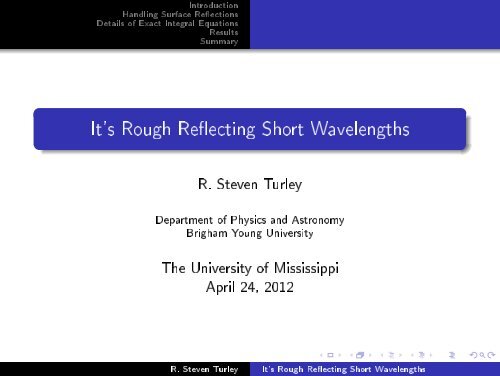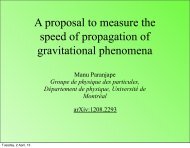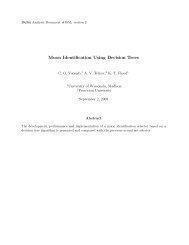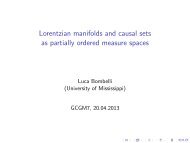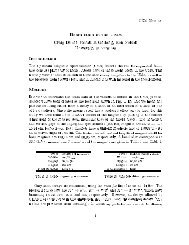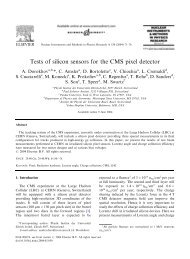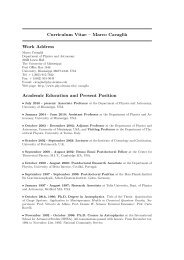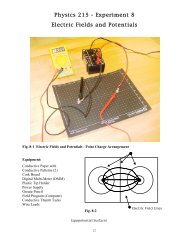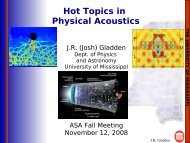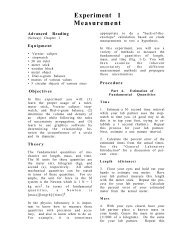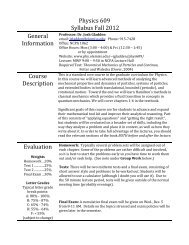It's Rough Reflecting Short Wavelengths - Physics and Astronomy ...
It's Rough Reflecting Short Wavelengths - Physics and Astronomy ...
It's Rough Reflecting Short Wavelengths - Physics and Astronomy ...
Create successful ePaper yourself
Turn your PDF publications into a flip-book with our unique Google optimized e-Paper software.
Introduction<br />
H<strong>and</strong>ling Surface Reections<br />
Details of Exact Integral Equations<br />
Results<br />
Summary<br />
<strong>It's</strong> <strong>Rough</strong> Reecting <strong>Short</strong> <strong>Wavelengths</strong><br />
R. Steven Turley<br />
Department of <strong>Physics</strong> <strong>and</strong> <strong>Astronomy</strong><br />
Brigham Young University<br />
The University of Mississippi<br />
April 24, 2012<br />
R. Steven Turley <strong>It's</strong> <strong>Rough</strong> Reecting <strong>Short</strong> <strong>Wavelengths</strong>
Outline<br />
Introduction<br />
H<strong>and</strong>ling Surface Reections<br />
Details of Exact Integral Equations<br />
Results<br />
Summary<br />
1 Introduction<br />
Why XUV is Interesting<br />
Challenges<br />
2 H<strong>and</strong>ling Surface Reections<br />
Problem Denition<br />
<strong>Short</strong> <strong>and</strong> Long Wavelength Limits<br />
Arbitrary Accuracy<br />
3 Details of Exact Integral Equations<br />
Model Problem<br />
Method of Moments<br />
Numerical Quadrature<br />
Nyström Technique<br />
4 Results<br />
R. Steven Turley <strong>It's</strong> <strong>Rough</strong> Reecting <strong>Short</strong> <strong>Wavelengths</strong>
Introduction<br />
H<strong>and</strong>ling Surface Reections<br />
Details of Exact Integral Equations<br />
Results<br />
Summary<br />
Electromagnetic Spectrum<br />
XUV Interest<br />
Challenges<br />
R. Steven Turley <strong>It's</strong> <strong>Rough</strong> Reecting <strong>Short</strong> <strong>Wavelengths</strong>
Applications<br />
Introduction<br />
H<strong>and</strong>ling Surface Reections<br />
Details of Exact Integral Equations<br />
Results<br />
Summary<br />
XUV Interest<br />
Challenges<br />
smaller, faster computers<br />
high-resolution light microscopes<br />
plasma images<br />
fusion reactors<br />
stars<br />
Earth's magnetosphere<br />
nuclear weapons<br />
R. Steven Turley <strong>It's</strong> <strong>Rough</strong> Reecting <strong>Short</strong> <strong>Wavelengths</strong>
Challenges<br />
Introduction<br />
H<strong>and</strong>ling Surface Reections<br />
Details of Exact Integral Equations<br />
Results<br />
Summary<br />
XUV Interest<br />
Challenges<br />
air is black (strongly absorbing)<br />
index of refraction for everything is complex<br />
real part is close to one (low reectivity)<br />
imaginary part is signicant (high absorption)<br />
surface contamination is deadly<br />
oxidation reduces reection<br />
short wavelength<br />
uniformity of layer thicknesses is critical<br />
very sensitive to surface irregularities<br />
R. Steven Turley <strong>It's</strong> <strong>Rough</strong> Reecting <strong>Short</strong> <strong>Wavelengths</strong>
Problem Denition<br />
Introduction<br />
H<strong>and</strong>ling Surface Reections<br />
Details of Exact Integral Equations<br />
Results<br />
Summary<br />
Problem Denition<br />
<strong>Short</strong> <strong>and</strong> Long Wavelength Limits<br />
Arbitrary Accuracy<br />
Incident plane wave<br />
Interaction with optical surface<br />
induced surface current<br />
Final State<br />
direct interaction from incident wave<br />
self interaction from other parts of surface<br />
continuing incident wave<br />
scattered (reected wave)<br />
interested in the far eld<br />
R. Steven Turley <strong>It's</strong> <strong>Rough</strong> Reecting <strong>Short</strong> <strong>Wavelengths</strong>
Simplications<br />
Introduction<br />
H<strong>and</strong>ling Surface Reections<br />
Details of Exact Integral Equations<br />
Results<br />
Summary<br />
Problem Denition<br />
<strong>Short</strong> <strong>and</strong> Long Wavelength Limits<br />
Arbitrary Accuracy<br />
To better visualize qualitative features of process<br />
2d scattering<br />
wave in x-y plane<br />
wave <strong>and</strong> scatterer invariant in the z direction<br />
scalar wave<br />
no polarization<br />
only one eld<br />
perfect electrical conductor<br />
eld is zero at the surface<br />
R. Steven Turley <strong>It's</strong> <strong>Rough</strong> Reecting <strong>Short</strong> <strong>Wavelengths</strong>
Plane Wave<br />
Introduction<br />
H<strong>and</strong>ling Surface Reections<br />
Details of Exact Integral Equations<br />
Results<br />
Summary<br />
Problem Denition<br />
<strong>Short</strong> <strong>and</strong> Long Wavelength Limits<br />
Arbitrary Accuracy<br />
ψ(x,y) = R<br />
(e )<br />
i(⃗ k·⃗r−ωt)<br />
= cos(k x x + k y y − ωt)<br />
k = 2πn<br />
λ 0<br />
ω = 2πν<br />
take real part at end<br />
drop time dependence<br />
focus on peak locations<br />
R. Steven Turley <strong>It's</strong> <strong>Rough</strong> Reecting <strong>Short</strong> <strong>Wavelengths</strong>
Scattering Process<br />
Introduction<br />
H<strong>and</strong>ling Surface Reections<br />
Details of Exact Integral Equations<br />
Results<br />
Summary<br />
Problem Denition<br />
<strong>Short</strong> <strong>and</strong> Long Wavelength Limits<br />
Arbitrary Accuracy<br />
incident<br />
scattered<br />
surface<br />
R. Steven Turley <strong>It's</strong> <strong>Rough</strong> Reecting <strong>Short</strong> <strong>Wavelengths</strong>
Introduction<br />
H<strong>and</strong>ling Surface Reections<br />
Details of Exact Integral Equations<br />
Results<br />
Summary<br />
<strong>Short</strong> Wavelength <strong>Rough</strong>ness<br />
Problem Denition<br />
<strong>Short</strong> <strong>and</strong> Long Wavelength Limits<br />
Arbitrary Accuracy<br />
short wavelength limit: geometrical optics (ray tracing)<br />
leaves out wave nature of light (diraction)<br />
add diraction<br />
physical optics<br />
leaves out<br />
self interactions of currents on mirror<br />
surface traveling waves<br />
R. Steven Turley <strong>It's</strong> <strong>Rough</strong> Reecting <strong>Short</strong> <strong>Wavelengths</strong>
Ray Optics<br />
Introduction<br />
H<strong>and</strong>ling Surface Reections<br />
Details of Exact Integral Equations<br />
Results<br />
Summary<br />
Problem Denition<br />
<strong>Short</strong> <strong>and</strong> Long Wavelength Limits<br />
Arbitrary Accuracy<br />
replace phase fronts with<br />
vectors in direction of<br />
propagation<br />
apply Snell's Law at each<br />
point on reecting surface<br />
allow multiple bounces<br />
shadow regions<br />
unilluminated<br />
R. Steven Turley <strong>It's</strong> <strong>Rough</strong> Reecting <strong>Short</strong> <strong>Wavelengths</strong>
Surface<br />
Introduction<br />
H<strong>and</strong>ling Surface Reections<br />
Details of Exact Integral Equations<br />
Results<br />
Summary<br />
Problem Denition<br />
<strong>Short</strong> <strong>and</strong> Long Wavelength Limits<br />
Arbitrary Accuracy<br />
R. Steven Turley <strong>It's</strong> <strong>Rough</strong> Reecting <strong>Short</strong> <strong>Wavelengths</strong>
Introduction<br />
H<strong>and</strong>ling Surface Reections<br />
Details of Exact Integral Equations<br />
Results<br />
Summary<br />
Far Field Distributions<br />
Gaussian Noise in Surface Angle<br />
Problem Denition<br />
<strong>Short</strong> <strong>and</strong> Long Wavelength Limits<br />
Arbitrary Accuracy<br />
R. Steven Turley <strong>It's</strong> <strong>Rough</strong> Reecting <strong>Short</strong> <strong>Wavelengths</strong>
Adding Diraction<br />
Physical Optics<br />
Introduction<br />
H<strong>and</strong>ling Surface Reections<br />
Details of Exact Integral Equations<br />
Results<br />
Summary<br />
Problem Denition<br />
<strong>Short</strong> <strong>and</strong> Long Wavelength Limits<br />
Arbitrary Accuracy<br />
assume surface is locally smooth<br />
compute surface current based on what one would get from an<br />
innite smooth surface<br />
in far eld<br />
∫<br />
φ(x,y) ∝ √ eikρ<br />
kρ<br />
S<br />
J(x ′ ,y ′ )e i⃗ k i ·⃗s ′ d⃗s ′<br />
ρ = √ x 2 + y 2<br />
)<br />
J(⃗s) =<br />
(e i⃗p·⃗s + e i⃗q·⃗s sinθ<br />
R. Steven Turley <strong>It's</strong> <strong>Rough</strong> Reecting <strong>Short</strong> <strong>Wavelengths</strong>
Introduction<br />
H<strong>and</strong>ling Surface Reections<br />
Details of Exact Integral Equations<br />
Results<br />
Summary<br />
Scattering Amplitude<br />
Problem Denition<br />
<strong>Short</strong> <strong>and</strong> Long Wavelength Limits<br />
Arbitrary Accuracy<br />
φ(ρ,θ f ) ∝ eikρ<br />
√<br />
kρ<br />
f (θ f )<br />
f (θ f ) = 8<br />
kL ei3π/4 sin(θ i ) sin(δ)<br />
δ<br />
δ = kL 2 [cosθ i − cosθ f )]<br />
R. Steven Turley <strong>It's</strong> <strong>Rough</strong> Reecting <strong>Short</strong> <strong>Wavelengths</strong>
Reected Intensity<br />
Smooth Plate, kL=200<br />
Introduction<br />
H<strong>and</strong>ling Surface Reections<br />
Details of Exact Integral Equations<br />
Results<br />
Summary<br />
Problem Denition<br />
<strong>Short</strong> <strong>and</strong> Long Wavelength Limits<br />
Arbitrary Accuracy<br />
0.0008<br />
0.0006<br />
0.0004<br />
0.0002<br />
35 40 45 50 55 60<br />
R. Steven Turley <strong>It's</strong> <strong>Rough</strong> Reecting <strong>Short</strong> <strong>Wavelengths</strong>
Reected Intensity<br />
<strong>Rough</strong> Plate, kL=200<br />
Introduction<br />
H<strong>and</strong>ling Surface Reections<br />
Details of Exact Integral Equations<br />
Results<br />
Summary<br />
Problem Denition<br />
<strong>Short</strong> <strong>and</strong> Long Wavelength Limits<br />
Arbitrary Accuracy<br />
3000<br />
2500<br />
2000<br />
1500<br />
1000<br />
500<br />
35 40 45 50 55 60<br />
degrees<br />
R. Steven Turley <strong>It's</strong> <strong>Rough</strong> Reecting <strong>Short</strong> <strong>Wavelengths</strong>
More <strong>Rough</strong>ness<br />
<strong>Rough</strong>er Plate, kL=200<br />
Introduction<br />
H<strong>and</strong>ling Surface Reections<br />
Details of Exact Integral Equations<br />
Results<br />
Summary<br />
Problem Denition<br />
<strong>Short</strong> <strong>and</strong> Long Wavelength Limits<br />
Arbitrary Accuracy<br />
intensity<br />
2500<br />
2000<br />
1500<br />
1000<br />
500<br />
35 40 45 50 55 60<br />
degrees<br />
R. Steven Turley <strong>It's</strong> <strong>Rough</strong> Reecting <strong>Short</strong> <strong>Wavelengths</strong>
Introduction<br />
H<strong>and</strong>ling Surface Reections<br />
Details of Exact Integral Equations<br />
Results<br />
Summary<br />
Dielectric <strong>Rough</strong> Plate<br />
Problem Denition<br />
<strong>Short</strong> <strong>and</strong> Long Wavelength Limits<br />
Arbitrary Accuracy<br />
more complete solution<br />
E s z = kg(ρ)e i 3π 4<br />
∫<br />
r s exp { ik[x ′ (cosθ i − cosθ r ) − y ′ (sinθ i + sinθ r )] }<br />
dy<br />
×<br />
(S ′ )<br />
sinθ i + sinθ r − cosθ r<br />
dx ′ dx ′<br />
r s is Fresnel reection coecient<br />
√<br />
S =<br />
1 +<br />
(<br />
dy ′<br />
dx ′ ) 2<br />
R. Steven Turley<br />
<strong>It's</strong> <strong>Rough</strong> Reecting <strong>Short</strong> <strong>Wavelengths</strong>
Dielectric Plate<br />
kL = 200π, 2000π<br />
Introduction<br />
H<strong>and</strong>ling Surface Reections<br />
Details of Exact Integral Equations<br />
Results<br />
Summary<br />
Problem Denition<br />
<strong>Short</strong> <strong>and</strong> Long Wavelength Limits<br />
Arbitrary Accuracy<br />
R. Steven Turley <strong>It's</strong> <strong>Rough</strong> Reecting <strong>Short</strong> <strong>Wavelengths</strong>
Introduction<br />
H<strong>and</strong>ling Surface Reections<br />
Details of Exact Integral Equations<br />
Results<br />
Summary<br />
Dielectric <strong>and</strong> Conducting Plate<br />
kL = 200π<br />
Problem Denition<br />
<strong>Short</strong> <strong>and</strong> Long Wavelength Limits<br />
Arbitrary Accuracy<br />
R. Steven Turley <strong>It's</strong> <strong>Rough</strong> Reecting <strong>Short</strong> <strong>Wavelengths</strong>
Introduction<br />
H<strong>and</strong>ling Surface Reections<br />
Details of Exact Integral Equations<br />
Results<br />
Summary<br />
Intermediate <strong>Wavelengths</strong><br />
Problem Denition<br />
<strong>Short</strong> <strong>and</strong> Long Wavelength Limits<br />
Arbitrary Accuracy<br />
diraction is a large correction, sometimes dominant<br />
solution<br />
develop integral equation using Greene's function<br />
more robust than dierential equation solutions<br />
compact domain for homogeneous materials<br />
solve equation numerically using Nyström technique<br />
ecient <strong>and</strong> high order<br />
R. Steven Turley <strong>It's</strong> <strong>Rough</strong> Reecting <strong>Short</strong> <strong>Wavelengths</strong>
Introduction<br />
H<strong>and</strong>ling Surface Reections<br />
Details of Exact Integral Equations<br />
Results<br />
Summary<br />
Exact Integral Equations<br />
Model Problem<br />
Method of Moments<br />
Numerical Quadrature<br />
Nyström Technique<br />
Research<br />
vector wave equation in 2d <strong>and</strong> 3d derived form Maxwell's<br />
Equations<br />
special care taken with singularities <strong>and</strong> boundary conditions<br />
Scalar analog<br />
no polarization<br />
simple Dirichlet boundary condition<br />
illustrates techniques <strong>and</strong> basic results<br />
R. Steven Turley <strong>It's</strong> <strong>Rough</strong> Reecting <strong>Short</strong> <strong>Wavelengths</strong>
Introduction<br />
H<strong>and</strong>ling Surface Reections<br />
Details of Exact Integral Equations<br />
Results<br />
Summary<br />
Scalar Wave Equation<br />
Model Problem<br />
Method of Moments<br />
Numerical Quadrature<br />
Nyström Technique<br />
(<br />
∇ 2 − 1<br />
c 2 ∂ 2<br />
∂ t 2 )<br />
ξ (⃗r,t) = 0<br />
separation of variables (or Fourier Transform)<br />
ξ (⃗r,t) = ψ(⃗r)τ(t)<br />
c 2 τ(t)∇ 2 ψ(⃗r) − ψ(⃗r)τ ′′ (t) = 0<br />
c 2 ∇2 ψ( ⃗ r)<br />
ψ(⃗r)<br />
− τ′′ (t)<br />
τ(t) = 0 .<br />
set both terms equal to −ω 2 = −k 2 c 2<br />
R. Steven Turley <strong>It's</strong> <strong>Rough</strong> Reecting <strong>Short</strong> <strong>Wavelengths</strong>
Introduction<br />
H<strong>and</strong>ling Surface Reections<br />
Details of Exact Integral Equations<br />
Results<br />
Summary<br />
Single Frequency Solutions<br />
Model Problem<br />
Method of Moments<br />
Numerical Quadrature<br />
Nyström Technique<br />
(<br />
∇ 2 + k 2) ψ(⃗r) = ρ(⃗r)<br />
τ ′′ (t) = −ω 2 τ(t)<br />
τ(t) = e ±iωt<br />
use e iωt <strong>and</strong> allow negative frequencies<br />
restrict solution to single frequency (<strong>and</strong> wavelength)<br />
general time-domain solutions built by superposition<br />
R. Steven Turley <strong>It's</strong> <strong>Rough</strong> Reecting <strong>Short</strong> <strong>Wavelengths</strong>
Introduction<br />
H<strong>and</strong>ling Surface Reections<br />
Details of Exact Integral Equations<br />
Results<br />
Summary<br />
Greene's Function Solution<br />
Model Problem<br />
Method of Moments<br />
Numerical Quadrature<br />
Nyström Technique<br />
(<br />
∇ 2 + k 2) G(⃗r,⃗r ′ ) = δ(⃗r −⃗r ′ )<br />
solution is Fredholm Integral Equation<br />
∫<br />
ψ(⃗r) = φ(⃗r) + G(⃗r,⃗r ′ )ρ(⃗r ′ )d⃗r ′<br />
S<br />
(<br />
∇ 2 + k 2) φ(⃗r) = 0<br />
choose plane wave solutions for φ for our case.<br />
ψ is the total eld <strong>and</strong> ξ = ψ − φ is the scattered eld<br />
On surface, Dirichelt Boundary condition requires ψ = 0<br />
∫<br />
φ(⃗r) = − G(⃗r,⃗r ′ )ρ(⃗r ′ )d⃗r ′<br />
S<br />
R. Steven Turley <strong>It's</strong> <strong>Rough</strong> Reecting <strong>Short</strong> <strong>Wavelengths</strong>
Introduction<br />
H<strong>and</strong>ling Surface Reections<br />
Details of Exact Integral Equations<br />
Results<br />
Summary<br />
Model Problem<br />
Method of Moments<br />
Numerical Quadrature<br />
Nyström Technique<br />
Validity of Greene's Function Solution<br />
(<br />
∇ 2 + k 2) ψ = [( ∇ 2 + k 2) φ(⃗r) ] ∫<br />
+<br />
(<br />
∇ 2 + k 2) G(⃗r,⃗r ′ )ρ(⃗r ′ )d⃗r ′<br />
∫<br />
= [0] + δ(⃗r −⃗r ′ )ρ(⃗r ′ )d⃗r ′<br />
S<br />
= ρ(⃗r)<br />
S<br />
legitimacy of switching order of integration <strong>and</strong> dierentiation<br />
surface should be smooth<br />
care required for surface charge distribution<br />
less of a problem for Dirichlet boundary conditions<br />
R. Steven Turley <strong>It's</strong> <strong>Rough</strong> Reecting <strong>Short</strong> <strong>Wavelengths</strong>
Greene's Function<br />
Introduction<br />
H<strong>and</strong>ling Surface Reections<br />
Details of Exact Integral Equations<br />
Results<br />
Summary<br />
Model Problem<br />
Method of Moments<br />
Numerical Quadrature<br />
Nyström Technique<br />
nd solution to<br />
(<br />
∇ 2 + k 2) G(⃗r,⃗r ′ ) = δ(⃗r −⃗r ′ )<br />
which satises boundary conditions of outgoing spherical wave<br />
for large r<br />
skipping details<br />
complication<br />
Y 0 (z) is singular at z = 0<br />
G(⃗r,⃗r ′ ) = i 4 H(1) 0 (kr)<br />
r = |⃗r −⃗r ′ |<br />
H (1)<br />
0 (z) = J 0(z) + iY 0 (z)<br />
R. Steven Turley <strong>It's</strong> <strong>Rough</strong> Reecting <strong>Short</strong> <strong>Wavelengths</strong>
Introduction<br />
H<strong>and</strong>ling Surface Reections<br />
Details of Exact Integral Equations<br />
Results<br />
Summary<br />
Solving Integral Equation<br />
Model Problem<br />
Method of Moments<br />
Numerical Quadrature<br />
Nyström Technique<br />
∫<br />
φ(⃗r) = − G(⃗r,⃗r ′ )ρ(⃗r ′ )d⃗r ′<br />
S<br />
φ is known (incident plane wave)<br />
G is known (Greene's function listed above)<br />
solve for ρ inside integral<br />
original approach: Method of Moments<br />
current approach: Nyström Technique<br />
R. Steven Turley <strong>It's</strong> <strong>Rough</strong> Reecting <strong>Short</strong> <strong>Wavelengths</strong>
Current Expansion<br />
Introduction<br />
H<strong>and</strong>ling Surface Reections<br />
Details of Exact Integral Equations<br />
Results<br />
Summary<br />
Model Problem<br />
Method of Moments<br />
Numerical Quadrature<br />
Nyström Technique<br />
Exp<strong>and</strong> unknown ρ in a series of compact basis functions<br />
Tricks for ecient success<br />
b i<br />
b i<br />
−ρ(⃗r) = ∑I i b i (⃗r)<br />
i<br />
have correct symmetry<br />
have correct physics (reduces number of required terms)<br />
substitute into integral equation<br />
∫<br />
[ ]<br />
φ(⃗r) = G(⃗r,⃗r ′ ) ∑I i b i (⃗r ′ )<br />
S<br />
i<br />
d⃗r ′<br />
R. Steven Turley <strong>It's</strong> <strong>Rough</strong> Reecting <strong>Short</strong> <strong>Wavelengths</strong>
Introduction<br />
H<strong>and</strong>ling Surface Reections<br />
Details of Exact Integral Equations<br />
Results<br />
Summary<br />
Method of Moments<br />
Model Problem<br />
Method of Moments<br />
Numerical Quadrature<br />
Nyström Technique<br />
switch order of summation <strong>and</strong> integration<br />
∫<br />
φ(⃗r) = ∑I i G(⃗r,⃗r ′ )b i (⃗r ′ )d⃗r ′<br />
i S<br />
unknowns now outside integral<br />
Galerkin: multiply both sides by same basis vectors <strong>and</strong><br />
integrate<br />
∫<br />
∫ ∫<br />
φ(⃗r)b j (⃗r) = ∑I i G(⃗r,⃗r ′ )b i (⃗r ′ )b j (⃗r)d⃗r ′ d⃗r<br />
i S S<br />
this is just a matrix equation<br />
V j = ∑I i Z ij<br />
i<br />
R. Steven Turley <strong>It's</strong> <strong>Rough</strong> Reecting <strong>Short</strong> <strong>Wavelengths</strong>
Introduction<br />
H<strong>and</strong>ling Surface Reections<br />
Details of Exact Integral Equations<br />
Results<br />
Summary<br />
Performing Numerical Integrations<br />
Sums of Rectangles<br />
Model Problem<br />
Method of Moments<br />
Numerical Quadrature<br />
Nyström Technique<br />
sums of rectangles<br />
∫<br />
f (x)dx ≈ h∑f (x i )<br />
exact for piecewise constant<br />
R. Steven Turley <strong>It's</strong> <strong>Rough</strong> Reecting <strong>Short</strong> <strong>Wavelengths</strong>
Trapezoidal Rule<br />
Introduction<br />
H<strong>and</strong>ling Surface Reections<br />
Details of Exact Integral Equations<br />
Results<br />
Summary<br />
Model Problem<br />
Method of Moments<br />
Numerical Quadrature<br />
Nyström Technique<br />
sums of trapezoids<br />
∫<br />
f (x)dx ≈ h<br />
exact for piecewise linear<br />
[<br />
N−1<br />
1<br />
2 (f (x 1) + f (x N )) +<br />
∑<br />
i=2<br />
f (x i )<br />
R. Steven Turley <strong>It's</strong> <strong>Rough</strong> Reecting <strong>Short</strong> <strong>Wavelengths</strong><br />
]
Introduction<br />
H<strong>and</strong>ling Surface Reections<br />
Details of Exact Integral Equations<br />
Results<br />
Summary<br />
Gaussian Quadrature<br />
Model Problem<br />
Method of Moments<br />
Numerical Quadrature<br />
Nyström Technique<br />
∫<br />
f (x)dx ≈<br />
N<br />
∑<br />
i=1<br />
w i f (x i )<br />
choose w i <strong>and</strong> x i so integrals are exact for polynomials up to<br />
order 2N − 1<br />
very ecient<br />
can be applied in piecewise fashion<br />
variations<br />
equally spaced points<br />
exact for products of monomials <strong>and</strong> logs<br />
R. Steven Turley <strong>It's</strong> <strong>Rough</strong> Reecting <strong>Short</strong> <strong>Wavelengths</strong>
Introduction<br />
H<strong>and</strong>ling Surface Reections<br />
Details of Exact Integral Equations<br />
Results<br />
Summary<br />
Nyström Technique<br />
Model Problem<br />
Method of Moments<br />
Numerical Quadrature<br />
Nyström Technique<br />
In process of integrating Method of Moments found shortcut<br />
Consider doing integral equation numerically<br />
∫<br />
φ(⃗r) = − G(⃗r,⃗r ′ )ρ(⃗r ′ )d⃗r ′<br />
S<br />
≈ −∑<br />
i<br />
w i G(⃗r,⃗r ′<br />
i )ρ i<br />
Solve for ρ i by requiring these equations to be satised at the<br />
same points as the discretization<br />
better numerical stability<br />
useful for later compution of far eld integrals<br />
R. Steven Turley <strong>It's</strong> <strong>Rough</strong> Reecting <strong>Short</strong> <strong>Wavelengths</strong>
Solution<br />
Introduction<br />
H<strong>and</strong>ling Surface Reections<br />
Details of Exact Integral Equations<br />
Results<br />
Summary<br />
Model Problem<br />
Method of Moments<br />
Numerical Quadrature<br />
Nyström Technique<br />
straightforward linear algebra<br />
φ(⃗r j ) ≈ −∑w i G(⃗r j ,⃗r i )ρ i<br />
i<br />
problem when i = j: G(⃗r i ,⃗r i ) in singular<br />
special technique for treating matrix elements on same local<br />
patch<br />
R. Steven Turley <strong>It's</strong> <strong>Rough</strong> Reecting <strong>Short</strong> <strong>Wavelengths</strong>
Notes on Solutions<br />
Introduction<br />
H<strong>and</strong>ling Surface Reections<br />
Details of Exact Integral Equations<br />
Results<br />
Summary<br />
Model Problem<br />
Method of Moments<br />
Numerical Quadrature<br />
Nyström Technique<br />
Single 2D problem up to 1000 wavelengths can be solved on<br />
PC<br />
Complete solution requires supercomputer<br />
Good results for initial surface<br />
Improved surface model based on AFM data<br />
R. Steven Turley <strong>It's</strong> <strong>Rough</strong> Reecting <strong>Short</strong> <strong>Wavelengths</strong>
Introduction<br />
H<strong>and</strong>ling Surface Reections<br />
Details of Exact Integral Equations<br />
Results<br />
Summary<br />
Previous Predictions<br />
Debye-Waller Attenuation<br />
R = R 0 exp [ −(qh) 2]<br />
q =2π sinθ/λ<br />
h is surface roughness height<br />
Nevot-Croce<br />
Assume form<br />
R = R 0 exp [ −q 1 q 2 h 2]<br />
R = R 0 exp[f (θ,h,σ)]<br />
R. Steven Turley <strong>It's</strong> <strong>Rough</strong> Reecting <strong>Short</strong> <strong>Wavelengths</strong>
Introduction<br />
H<strong>and</strong>ling Surface Reections<br />
Details of Exact Integral Equations<br />
Results<br />
Summary<br />
Calculation Comparisons<br />
Conductor<br />
R. Steven Turley <strong>It's</strong> <strong>Rough</strong> Reecting <strong>Short</strong> <strong>Wavelengths</strong>
Parameterization<br />
Introduction<br />
H<strong>and</strong>ling Surface Reections<br />
Details of Exact Integral Equations<br />
Results<br />
Summary<br />
f = α(qh) 3 + β(qh) 2 + γ(qh)<br />
R. Steven Turley <strong>It's</strong> <strong>Rough</strong> Reecting <strong>Short</strong> <strong>Wavelengths</strong>
Future Work<br />
Introduction<br />
H<strong>and</strong>ling Surface Reections<br />
Details of Exact Integral Equations<br />
Results<br />
Summary<br />
periodic surfaces<br />
TE polarization<br />
3d surfaces<br />
parameterization to avoid need for expensive supercomputer<br />
calculations<br />
non-abrupt interfaces<br />
application in visible (ecient solar cells)<br />
R. Steven Turley <strong>It's</strong> <strong>Rough</strong> Reecting <strong>Short</strong> <strong>Wavelengths</strong>
Application<br />
Black Chrome <strong>Rough</strong>ness<br />
Introduction<br />
H<strong>and</strong>ling Surface Reections<br />
Details of Exact Integral Equations<br />
Results<br />
Summary<br />
Groove width: 18 ± 1 µm<br />
R. Steven Turley <strong>It's</strong> <strong>Rough</strong> Reecting <strong>Short</strong> <strong>Wavelengths</strong>
Introduction<br />
H<strong>and</strong>ling Surface Reections<br />
Details of Exact Integral Equations<br />
Results<br />
Summary<br />
Nonspecular Reection<br />
25.6 nm at 10 ◦<br />
R. Steven Turley <strong>It's</strong> <strong>Rough</strong> Reecting <strong>Short</strong> <strong>Wavelengths</strong>
Introduction<br />
H<strong>and</strong>ling Surface Reections<br />
Details of Exact Integral Equations<br />
Results<br />
Summary<br />
Preliminary Dielectric Data<br />
R. Steven Turley <strong>It's</strong> <strong>Rough</strong> Reecting <strong>Short</strong> <strong>Wavelengths</strong>
Summary<br />
Introduction<br />
H<strong>and</strong>ling Surface Reections<br />
Details of Exact Integral Equations<br />
Results<br />
Summary<br />
roughness calculation important in XUV<br />
computing roughness eects requires care<br />
integral equations with Nyström solution a good approach<br />
applications to acoustic waves <strong>and</strong> other wavelengths<br />
R. Steven Turley <strong>It's</strong> <strong>Rough</strong> Reecting <strong>Short</strong> <strong>Wavelengths</strong>
Acknowledgements<br />
Introduction<br />
H<strong>and</strong>ling Surface Reections<br />
Details of Exact Integral Equations<br />
Results<br />
Summary<br />
Hughes Research <strong>and</strong> Yale<br />
Students<br />
Stephen W<strong>and</strong>zura<br />
Vladimir Rohklin<br />
Jed Johnson<br />
Todd Doughty<br />
Elise Martin<br />
Greg Hart<br />
Samuel Kellar<br />
others...<br />
R. Steven Turley <strong>It's</strong> <strong>Rough</strong> Reecting <strong>Short</strong> <strong>Wavelengths</strong>


